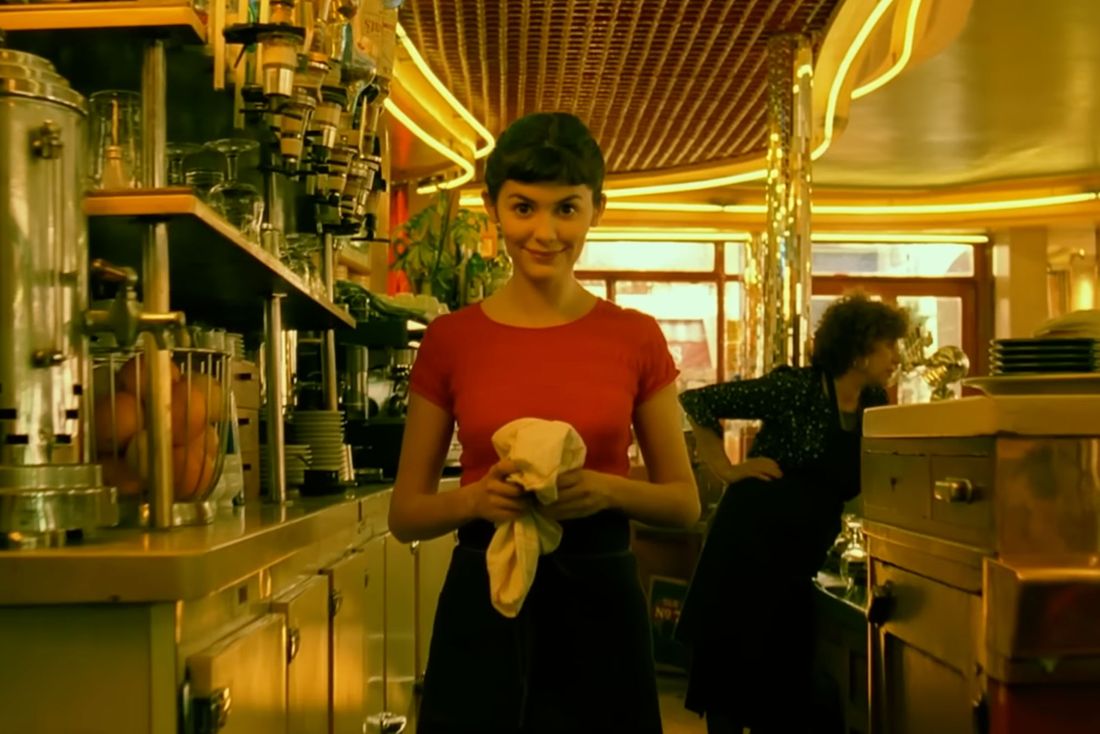
From the moment that 2001 audiences saw Amélie’s initial cascade of storybook images flash across the screen and heard the bourbon-y rumble of its third-person narrator describing the yearning and kindness of its title character and the daily struggles of ordinary citizens, they knew they were in for something special. French filmmaker Jean-Pierre Jeunet’s ode to the magic of Paris became the top-grossing film of the director’s career as well as his biggest critical hit, earning awards from groups around the globe. The movie is being rereleased globally today: The occasion is Valentine’s Day, but as Jeunet told us in a wide-ranging interview about the movie, he doesn’t consider Amélie to be a romance.
Where did Amélie come from?
I quit Paris for Hollywood when I made Alien Resurrection. Then I came back to Paris and decided I wanted to make Amélie. For years and years, I had taken notes on computers, because I am keen to remember good memories, good souvenirs, good anecdotes, good stories. I had plenty of notes, but it was difficult to find the main story in them. I spent a lot of time wondering, Is it a thriller? Is it a love story? One morning, I read my notes and came across one small detail. And I thought, “Oh! This is the main story!” Then it got easy. Easy to write, easy to shoot — not easy to find the money, of course!
What did you settle on for the main story?
The story of a girl helping other people. That story came from the one detail in my notes, which is, believe it or not: I was in Paris one time, and I saw this guy, and he was — how can I say? — without legs. Like in a western: He was in a box with wheels on it! Moving around like this [sweeps both arms downward repeatedly]. And I thought, Oh my God. Maybe this guy has some friends? And they form a kind of an association? And then they help other people? Because life can be just a piece of shit, you know? You need help from other people.
Since it’s going to be rereleased internationally on Valentine’s Day, I wanted to ask: Do you think of Amélie as a romance?
No.
If it’s not about romance, what’s it about?
The story is: Because Amélie never asks for something in return for helping other people, she wins something. What she wins is love.
What specific films did you have in mind as you were making Amélie?
There were many, but I don’t know if you can recognize them in Amélie. The most important film in my life for a long time was Once Upon a Time in the West. I saw it when I was 17. I couldn’t speak for three days. I swear! Finally my parents asked me, “Are you sick?” I said, “No. You cannot understand!”
What does Once Upon a Time in the West have to do with Amélie?
Nothing! [Laughs.] No, no, no …. wait a minute. Maybe the way you use a long lens to shoot a close-up? Sergio Leone’s close-ups at the beginning of that western are incredible. Also, the film’s sound design. A Clockwork Orange is another one that influenced me. I saw it 14 times in a theater. At that time, there were no VCRs! Can you believe it? A Clockwork Orange, 14 times? It’s not the sort of thing you want to see with your family, of course! It’s all a question of style. Even if you can’t see my influences, they’re in there.
I thought of Wings of Desire as I watched it again.
Oh, yes! There are certain details from Wings of Desire in there, exactly! The parts where people think about the little things in life — the first drop of rainwater to land on the sidewalk, for example. But you know how it is when you make a film: You like a lot of different things, and you mix them all together and try to make something new.
What was the inspiration for Amélie finding the little boy’s box hidden behind a piece of baseboard tile in her bathroom?
That was from Wim Wenders’s film, a beautiful film in black-and-white, Kings of the Road. Rüdiger Vogler visits a very old house, and under the house, he finds a box. Wenders has said that moment was an homage to his hero Nicholas Ray, who directed a film about rodeo riders, The Lusty Men. There’s a scene at the beginning of that film where Robert Mitchum goes into a very old house and reaches through some cobwebs under a crawl space and finds a box with some of his childhood things, including a small toy gun and some books. So I pay homage to Wim Wenders’s homage to Nicholas Ray! It’s un hommage en ricochet.
Ricochet? Like a bullet?
Yes! [Mimes a bullet ricocheting off the borders of his computer screen.] Tung! Tung! Tung!
I had seen your previous films prior to Amélie, and I remember thinking that it felt different from the others. There’s a third-person narrator, like in The Age of Innocence or The Royal Tenenbaums. You have a lot, and I mean a lot, of characters, and a lot of narrative, too. And the cuts are very fast throughout, compared to your other films.
Yes! Also, another big difference: I shot a lot of it outdoors. I hate that. On a soundstage, you can control everything. When you’re outdoors, there is somebody else who is the master. [Points up.] He gives you some clouds or some sun, when you want or when you don’t want. I don’t like that!
Especially in Paris. People are not very cooperative with filmmakers like they are in America. One day a guy parked his car right in front of the camera and said, “Fuck the cinema!” [Laughs.] We had to wait an hour for the guy to leave. When we were shooting the scene at the magazine store, there was a guy dealing drugs or something. He had a bike. Whenever I said “Rolling,” he went: [Mimes ringing a bicycle bell.] Ding! Ding! Ding! Ding! Ding! And he kept doing it! “Rolling!” Ding! Ding! Ding! Ding! Ding! “Rolling!” Ding! Ding! Ding! Ding! Ding! And of course if you give him money to make him stop, another arrives immediately. John Huston had the same problem in Paris when he shot Moulin Rouge.
There are so many props in this film that are unique, like Nino’s book of reassembled passport photos that were discarded by people using photo booths. Those all had to be fabricated, yes?
That’s right! I love production design. All of my films were nominated for the French film awards, the César. We had two nominations for Amélie for production design, for the César and BAFTA, and we won BAFTA. The garden gnome that Amelie sends around the world, that’s something that you can buy. But yes, so many things had to be made. For the pig lamp, I asked a German production designer, and we built it, and it’s in my office right now. The photo book that Nino has: We made that, but it’s based on a real book, from a true story about a guy who fixed passport photo-booth machines. That was another something I had in my collection of anecdotes. That photo book was real, but we couldn’t use it in the film because we couldn’t show the pictures in it.
Because you’d need to track all those people down and get them to sign releases?
That’s right. The pictures you see in the book that we show in the film are of my wife and some friends, you know — people like that. We also paid for some extras. It was a big frustration for all of them because I would tell them to sit down inside the photo booth and they expected to just be directed as they had their pictures taken, and instead I would go, “Boo!” and click the photo. Then, “Finished! Thank you!” It was ridiculous for them.
The locations were part of the production design as well. I did all of the location scouting myself on a scooter! You know? [Mimes riding a scooter and makes scooter noises.] I chose the subway station where so much action happens, the Abbesses metro station. Beautiful! I visited all the subway stations in Paris twice to make sure I chose the best one.
Amélie is far and away your most popular film in the United States —[Delighted] I know!
— and I find that especially interesting because, as you mentioned, you made it right after Alien Resurrection, your first and only Hollywood movie. And your next film isn’t just French. It’s super-French!
It is!
Is the super-Frenchness a reaction to Hollywood?
You’re not totally wrong. I came back to France after spending 20 months in Los Angeles. Los Angeles, you know, is such a weird city, with parking lots everywhere — it’s a little bit depressing. And then I came back to Paris and thought, My God! This is a beautiful city! Just beautiful! I had the same vision as when I went to Paris for the first time when I was 20 or 21 years old, just after I got out of the army. The city was a revelation. I wanted to show Paris through those eyes. So I cheated. I got rid of the cars parked on the street. I got rid of the dog shit on the streets. We changed all the posters. We made something a little bit fake.
Can you talk about the influence of fairy tales? It seems important in all of your work.
Do you know The Tale of Tom Thumb? He gets lost in the forest with some friends, and he puts some stones down so that he can find his way back to the house. This is a thing in all of my films. Also, in my films, there’s a kid — Amélie is not a kid, of course; but maybe a little bit, in a way? — who is fighting against a monster. For Amélie, the monster is not an alien or the Butcher from Delicatessen or the old man in City of Lost Children. The monster is introversion. Does that make sense? Amélie has to fight against that monster, and her weapon is imagination. This is my life, in fact.
What was your monster, if I may ask?
I won’t tell you what was my monster. It’s personal. But I will tell you that I saved my life with my imagination.
That’s a lovely sentiment. And it translates into the film, which is fundamentally optimistic.
I found, in my very first notes, a line: “This film has to be positive.” Meaning, this has to be a principle for us, to make a positive movie. It’s not easy to make a film that’s positive. Not too much sugar, you know what I mean? I hope I did that — sweet but not too sweet. If it’s too much, it can become a pain in the ass, even for me.
Why are upbeat films not taken as seriously as grim ones?
I don’t know. Maybe some critics, they prefer — especially in France — something very dark, something very uhhhhhh! [Makes sour face.] We are so inclined to be negative. But this one time, with Amélie, I had the audience, I had the awards, for a positive movie. The reviews were positive, too — maybe 98 percent.
How hard was it to get the movie made in the first place?
The original funders, Pathe, fired me. They didn’t want me doing it because they said it was too expensive. They told me I had to reduce the budget, and when I told them I couldn’t, they fired me. Similar kind of story with 20th Century Fox, which released Alien Resurrection. The boss of the studio at the time, Tom Rothman, said, “We would like to produce your next movie.” So I sent the script and I flew from Paris to Los Angeles to meet with them about Amélie. But at the meeting, I felt something was wrong. They seemed embarrassed. Tom Rothman said, “Uh, Jean-Pierre? The marketing service read it, and they said it’s not Titanic.” I said, “No, you’re right, it’s definitely not Titanic. It’s Amélie From Montmartre.”
It’s funny that they compared it negatively to Titanic, as if Titanic was a proven formula for success. The consensus prior to release was that Titanic was a folly that was going to destroy James Cameron and ruin the studios that co-funded it, 20th Century Fox and Paramount.
Yes, that’s true! And when Tom Rothman saw the finished Amélie, which was bought for the U.S. by Miramax, he was so pissed off, he probably fired people the next day.
Even Cannes rejected it, which seems absurd now.
You know, almost three years ago, for the 20th anniversary, Cannes showed it — an outdoor screening on the beach. It was a rainy day, so they warned me: “Probably we will have 50 people, no more.” It was packed! They had 800 people and they had to turn 200 people away. Probably everybody there had seen the film before. It was extraordinary.
What sorts of reactions do you get from younger filmmakers? Are they influenced by Amélie?
Oh, yes. Sometimes they come up to me and say, “Will you sign my DVD?” And I sign it, and they say, “This is the favorite film of my mother!” [Puts face in hands in mock despair.] But it’s okay! The film came out 23 years ago! I get asked a lot to make a sequel or a remake — as a film or as a TV series. But we know that we could never make it as good, so we reject the proposition.
How did Amélie do in countries besides France and the United States?
In Japan, it was a big success. Same reaction, everywhere, everywhere! That’s a source of great satisfaction to me, because when you write something like Amélie, relying on your own personal notes, you expect to have maybe one million admissions internationally, altogether. But by the end, the film became something bigger than us. We even had a screening with the president at the time, Jacques Chirac. As we say in France, it became un phénomène social — how to say it in English?
A social phenomenon?
Voilà! And I never expected that. I often used to think, Oh my God, I wish I could have a big success someday. I didn’t think I ever would. But sometimes it happens!
Do you ever worry that Amélie overshadows the rest of your work?
No. A filmmaker friend said to me, “It must be a problem for you to have had such a big success.” Everyone should have such problems!





